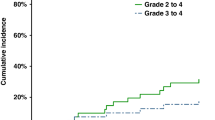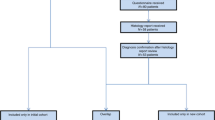Abstract
Leukemia cutis (LC) is a rare feature of acute myeloblastic leukemia (AML). Little information is available regarding its prognostic influence on post-transplant outcome. In our institution, 202 patients with AML received an allogeneic HLA-identical marrow transplant from related donors between March 1982 and January 1994. Thirteen patients had prior leukemic involvement of the skin (leukemia cutis or LC group) while 189 patients did not (non-LC group). There was a higher incidence of patients with the M4-M5 FAB subtypes in the LC group (83%) as compared to the non-LC group (33%). In addition, the percentage of patients transplanted in relapse was also higher in the LC group (69 vs 15%). While there were no differences observed in the rates of relapse post-transplant in the LC and non-LC groups when matched for stage of disease at transplant, the sites of relapse differed markedly. Five of six relapses in the LC group involved extramedullary sites as compared to only six of 38 relapses in the non-LC group (P = 0.002), with a 6-year probability of extramedullary relapse of 38.5% in the LC group as compared to 3.9% in the non-LC group. This increased probability of extramedullary relapse was independent of the FAB morphology (50 vs 2% for patients with the M4-M5 subtypes in the LC and the non-LC group respectively) and of disease status at the time of transplant. Moreover, only three relapses post-transplant involved the skin, all of which were in the LC group, with a probability of skin relapse of 23.1% in this group. Patients with AML and leukemia cutis have a remarkable propensity to relapse in extramedullary sites following marrow transplantation. These relapses occur in the skin as well as other organs. Further investigations are needed to understand the biological basis of this clinical feature.
This is a preview of subscription content, access via your institution
Access options
Subscribe to this journal
Receive 12 print issues and online access
$259.00 per year
only $21.58 per issue
Buy this article
- Purchase on Springer Link
- Instant access to full article PDF
Prices may be subject to local taxes which are calculated during checkout
Similar content being viewed by others
Author information
Authors and Affiliations
Rights and permissions
About this article
Cite this article
Michel, G., Boulad, F., Small, T. et al. Risk of extramedullary relapse following allogeneic bone marrow transplantation for acute myelogenous leukemia with leukemia cutis. Bone Marrow Transplant 20, 107–112 (1997). https://doi.org/10.1038/sj.bmt.1700857
Received:
Accepted:
Issue Date:
DOI: https://doi.org/10.1038/sj.bmt.1700857



